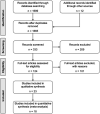Long-Term Hearing Outcome After Radiosurgery for Vestibular Schwannoma: A Systematic Review and Meta-Analysis
- PMID: 36735500
- PMCID: PMC10150847
- DOI: 10.1227/neu.0000000000002354
Long-Term Hearing Outcome After Radiosurgery for Vestibular Schwannoma: A Systematic Review and Meta-Analysis
Abstract
Background: Stereotactic radiosurgery (SRS) is one of the main treatment options in the management of small to medium size vestibular schwannomas (VSs), because of high tumor control rate and low cranial nerves morbidity. Series reporting long-term hearing outcome (>3 years) are scarce.
Objective: To perform a systematic review of the literature and meta-analysis, with the aim of focusing on long-term hearing preservation after SRS.
Methods: Using Preferred Reporting Items for Systematic Reviews and Meta-Analyses guidelines, we reviewed articles published between January 1990 and October 2020 and referenced in PubMed or Embase. Inclusion criteria were peer-reviewed clinical study or case series of VSs treated with SRS (single dose), reporting hearing outcome after SRS with a median or mean audiometric follow-up of at least 5 years. Hearing preservation, cranial nerves outcomes, and tumor control were evaluated.
Results: Twenty-three studies were included. Hearing preservation was found in 59.4% of cases (median follow-up 6.7 years, 1409 patients). Main favorable prognostic factors were young age, good hearing status, early treatment after diagnosis, small tumor volume, low marginal irradiation dose, and maximal dose to the cochlea. Tumor control was achieved in 96.1%. Facial nerve deficit and trigeminal neuropathy were found in 1.3% and 3.2% of patients, respectively, both significantly higher in Linear Accelerator series than Gamma Knife series ( P < .05).
Conclusion: Long-term hearing preservation remains one of the main issues after SRS, with a major impact on health-related quality of life. Our meta-analysis suggests that hearing preservation can be achieved in almost 60% of patients after a median follow-up of 6.7 years, irrespective of the technique.
Copyright © 2023 The Author(s). Published by Wolters Kluwer Health, Inc. on behalf of the Congress of Neurological Surgeons.
Figures






References
-
- Régis J, Pellet W, Delsanti C, et al. Functional outcome after gamma knife surgery or microsurgery for vestibular schwannomas. J Neurosurg. 2002;97(5):1091-1100. - PubMed
-
- Pollock BE, Driscoll CLW, Foote RL, et al. Patient outcomes after vestibular schwannoma management: a prospective comparison of microsurgical resection and stereotactic radiosurgery. Neurosurgery. 2006;59(1):77-85; discussion 77-85. - PubMed
-
- Golfinos JG, Hill TC, Rokosh R, et al. A matched cohort comparison of clinical outcomes following microsurgical resection or stereotactic radiosurgery for patients with small- and medium-sized vestibular schwannomas. J Neurosurg. 2016;125(6):1472-1482. - PubMed
Publication types
MeSH terms
LinkOut - more resources
Full Text Sources
Medical

